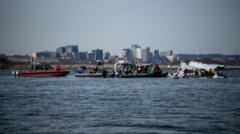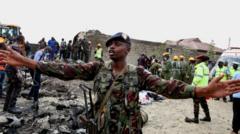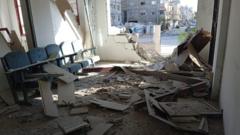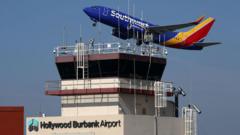Following a catastrophic collision between a military helicopter and a passenger plane that resulted in 67 fatalities, Transportation Secretary Sean Duffy has noted that air traffic control staffing was "not normal." Ongoing investigations will examine the adequacy of air traffic control procedures and operations during the incident.
Investigation into Mid-Air Collision Reveals Staffing Issues at Air Traffic Control

Investigation into Mid-Air Collision Reveals Staffing Issues at Air Traffic Control
Officials confirmed that air traffic control staffing was insufficient during the tragic mid-air collision in Washington, DC, leading to questions about procedural adequacy.
Air traffic control staffing was identified as a significant issue following a mid-air collision in Washington, DC, which tragically claimed the lives of 67 individuals. Secretary of Transportation Sean Duffy highlighted that the circumstances surrounding the air traffic control staffing at the time of the incident were "not normal," with reports indicating that the control tower at Reagan National Airport was understaffed on the day of the disaster.
Sources revealed to U.S. news outlets that one air traffic controller was responsible for managing both helicopters and incoming planes, which is typically a duty handled by two personnel. Secretary Duffy, speaking on the FOX News Sunday program, remarked, "I'll take the Federal Aviation Administration (FAA) at their word that it wasn't normal," and emphasized that reviewing such circumstances is imperative.
Duffy addressed the consolidation of air traffic controllers that occurred an hour before the crash, raising concerns regarding the appropriateness of this decision. He questioned whether proper traffic direction procedures were followed, particularly concerning the elevation at which the helicopter was operating. Initial data from the National Transportation Safety Board (NTSB) indicated that the incident involved a helicopter flying at 200 feet, a height that corresponds with regulatory guidelines in the vicinity of Reagan National Airport.
Moreover, Duffy pondered why the military chose to conduct their flight mission at 9 p.m., during a time of peak air traffic, rather than opting for a later time when airspace would be less congested. He expressed a desire for the military to maintain readiness while ensuring the safety of air travelers.
As investigators dissect the sequence of events that led to this aviation tragedy, they are exploring various elements, including flight height and timing. There were 64 passengers aboard the American Airlines flight when it collided with an Army Black Hawk helicopter that contained three soldiers, with no survivors reported from either aircraft.
Family members of the victims gathered at the crash site, paying their respects and seeking closure in the wake of the devastating incident. Duffy further acknowledged a pressing issue of chronic understaffing within U.S. air traffic control systems, revealing that over 90% of facilities are operating below FAA-recommended staffing levels. He affirmed that the air traffic controllers in the country are under significant stress, and while plans are in motion to address these issues, real solutions require time and sustained effort.





















